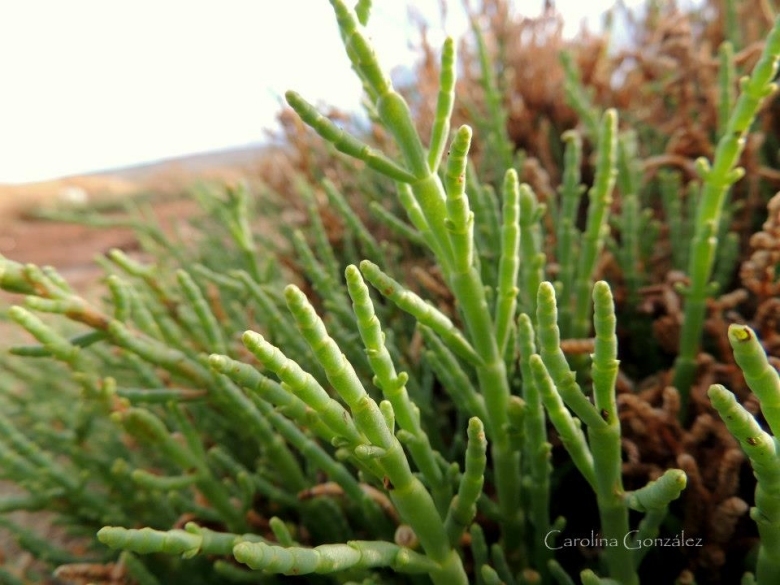Accepted Scientific Name: Allenrolfea vaginata (Griseb.) Kuntze
Revis. Gen. Pl. 2: 546 1891 Kuntze

Spirostachys vaginata (Allenrolfea vaginata) Photo by: Carolina González
Origin and Habitat: Allenrolfea vaginataSN|30979]]SN|30979]] is endemic to northern Argentina (Catamarca, La Pampa, La Rioja, Mendoza, Neuquen, Salta, Sgo. del Estero, Santa Fe, San Juan, San Luis, Tucumán) and Bolivia.
Altitude range: 0-500 Metres above sea level.
Habitat and ecology: Hygro-halophile communities of saline depressions, arroyos and inundatable alluvial fans of the Monte semideserts. It grows in sandy soil, often salty and alcaline and suffering periods of flooding. It is found intermingled with spinescent xeric shrubs and in some places with several tree cactus, which are able to tolerate a certain concentration of salts. This halophyte has developed mechanisms of adaptation that allow it to withstand the high concentration of salts.
Synonyms:
Common Names include:
SPANISH (Español): Jume, Jumecito, Jume negro
Description: Allenrolfea vaginataSN|30979]]SN|30979]] is a succulent, articulate perennial shrubs 1 to 2.5 m tall, with strongly reduces leaves that wrap the stem to form rings.
Stems: Densely branched, erect, knobby, green, fleshy and jointed at the internodes between segments.
Leaves: Strongly reduces appearing as flaky scales scattered across the surface of the stems.
Flowers: 3 to 5 in the axil of peltate, scale-like, persistent, spirally arranged, free bracts; perianth 4-5- lobed at the apex, unmodified in fruit. Stamens 1-2. Stigmas 2(-3).
Seeds: Vertical; embryo hooked; radicle inferior; perisperm abundant.
Bibliography: Major references and further lectueres
1) Soriano, A. 1947b; Giusti, L. 1984; Pensiero, J. F., Gutiérrez, H. F., Luchetti, A. M., Exner, E., Kern, V., Brnich, E., Oakley, L. J., Prado, D. E. & Lewis, J. P. “Flora vascular de la provincia de Santa Fe” 2005
2) Zuloaga, F. O. 1997. "Catálogo de las plantas vasculares de la Argentina." Monogr. Syst. Bot. Missouri Bot. Gard. 74(1–2): 1–1331.
3) Zuloaga, F. O., O. Morrone, M. J. Belgrano, C. Marticorena & E. Marchesi. (eds.) 2008. "Catálogo de las Plantas Vasculares del Cono Sur (Argentina, Sur de Brasil, Chile, Paraguay y Uruguay)." Monogr. Syst. Bot. Missouri Bot. Gard. 107(1): i–xcvi, 1–983; 107(2): i–xx, 985–2286; 107(3): i–xxi, 2287–3348.
4) J. R. Goodin, David K. Northington “Plant Resources of Arid and Semiarid Lands: A Global Perspective” Academic Press, 25 set 2013
5) Giménez, A. M.; M. E. Figueroa; P. Hernández; M. Cejas “Jume negro (Allenrolfea vaginata Kuntze, Chenopodiaceae): potencialidades de usos en la rigurosidad del ambiente salino” Quebracho N° 15 (32-36)
Cultivation and Propagation: Usually not cultivated.
Uses: Alkaline ashes are produced by Allenrolfea vaginataSN|30979]]SN|30979]], a species present in the monte, and are used in the production of soap and the preparation of olives.











